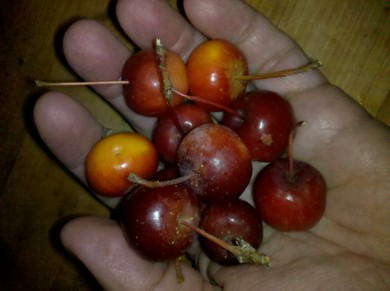Wild apples are just a few of the taste treats of fall

The Highbush Cranberry, along the Huron River. Be sure to confirm the identification before tasting; there are many look-a-like toxic red berries. This is usually a very sour fruit, requiring some preparation to be palatable.
Linda Diane Feldt | Contributor
This is a great time of year to sample food while on a walk. Both the streets of Ann Arbor as well as our many parks offer up a variety of foods to try.
The tastes range from tannin rich (puckery) grapes (Vitaceae family) to sweet (Rosa family) rosehips (they get sweeter with every cold night), to the less bitter dandelions (Taraxacum officinale), the mostly really sour Highbush Cranberries (Viburnum trilobum), the rare but wonderful Dew Berries (in the raspberry family - Rubus caesius) and then the fabulous range of apples, pears, paw paws and quince.
About the only cautions associated with the above list are to ensure you’re tasting grapes and not fruit from Virginia Creeper (Parthenocissus quinquefolia), and that the Highbush Cranberry is not another red berry likely to be toxic. Be sure the grapes are on a grape vine, the Virginia Creeper that often grows nearby has five leaves and a toxic berry. The Highbush Cranberry has a flat seed and a distinctive leaf you can see in the photo.
This has also been a fabulous season for mushrooms, and you’ll find a large variety tempting you in lawns, fields and woods. I refrain from giving any mushroom hunting advice in print. It isn’t easy to identify them for certain, and people easily misunderstand descriptions. The danger from making a mistake is very real, and I’m not going to encourage casual experimenting with mushroom hunting!
Both full-size and crab apple trees are common everywhere in town. You’ll find crab apples planted for their beautiful blossoms, with their fruit mostly ignored or even cited as a necessary evil to endure for the spring beauty. Apple trees can be found in odd places growing as a remnant of an orchard or planted with the intention of harvesting the fruit.
A lot of the apple trees around were grafted, and you may even be lucky to find a tree that has more than one kind of apple. I have an apple tree where the foundation tree is producing much of the fruit; the graft is clearly weaker and not producing much at all.

Beautiful and reasonably tasty crab apple in County Farm Park
Linda Diane Feldt | Contributor
An apple tree left alone will mostly offer up wormy, mottled and misshapen fruit. Compared with the perfection of fruit from a carefully-managed tree, most people would pass it up as too ugly to eat.
That would be a mistake. Those ugly apples can be the best around. And the price is certainly right!
A well prepared forager carries a knife to cut out the damaged spots, an inspired wildcrafter will just eat around the questionable parts. Ann Arbor has outstandingly tasty apple trees planted in the traffic medians, school yards, parks and lawn extensions. In previous years I’ve harvested grocery bags full of perfectly edible fruit. I’ve found as much as I can possibly process, without much effort at all.

These were the wonderful red crab apples I found along the Huron River. With a sweet and complex flavor, I've never tasted a better crab apple before. You never know until you taste them!
Linda Diane Feldt | Contributor
Crab apples are another matter altogether. I try and sample all the trees I see. This year I’ve been impressed with some large yellow fruit (large being relative — these were about the diameter of a quarter). In multiple locations these yellow crab apples have been sweet and not too fibrous.
Then I encountered a larger red crab apple near Island Park. These were the best crab apples I’ve ever had. They still had that crab apple sourness but a strong sweet flavor as well. A little chewy, but with a sustained rich flavor. These were interesting and complex, something I’ve never encountered in all my years of crab apple sampling. What a find!
I’ve made my share of applesauce from wild apples, as well as cider. Last year we mixed in some crab apples, and it improved the flavor of both — less sweet and more complex.
This year I’m doing some drying. It takes a long time, but those sweet bits mixed in with granola, cooked with oatmeal, or tossed into a salad, are a real treat. Even crab apples can be dried, and if they were good to begin with, the flavor is improved.
Linda Diane Feldt is a local Holistic Health Practitioner, author and teacher. You can follow her on twitter, or visit her website. Linda Diane is currently very busy preparing three new publications for release as serialized subscriptions, the third one beginning in January, will be weekly recipes using wild foods. The next free herbal wisdom class sponsored by The People’s Food Co-op will be on seven local roots you can still harvest. That class is Oct. 27, 7-8:30 p.m. at Crazy Wisdom Bookstore and Tea Room.


Comments
Linda Diane Feldt
Tue, Oct 4, 2011 : 10:18 p.m.
True, Atticus, but it is hard to sample the walnuts on a casual walk. I wish it didn't take so much work to get at the wonderful walnut meat within. But you need gloves, a hammer or other tool (some use a car) and often a nut pick. I'll collect them on a walk, but have to enjoy them much later, after a lot of hard messy work and effort!
Atticus F.
Tue, Oct 4, 2011 : 5:57 p.m.
Let's not forget about black walnuts!